EMS RESEARCH LIBRARY
Choose your area of interest to review the relevant research
Effects of Electro-Muscle Stimulation Exercise Combined with Mat Pilates on Pain, Anxiety, and Strength in Sedentary Females with Fibromyalgia: A Single-Blind Randomized Controlled Trial
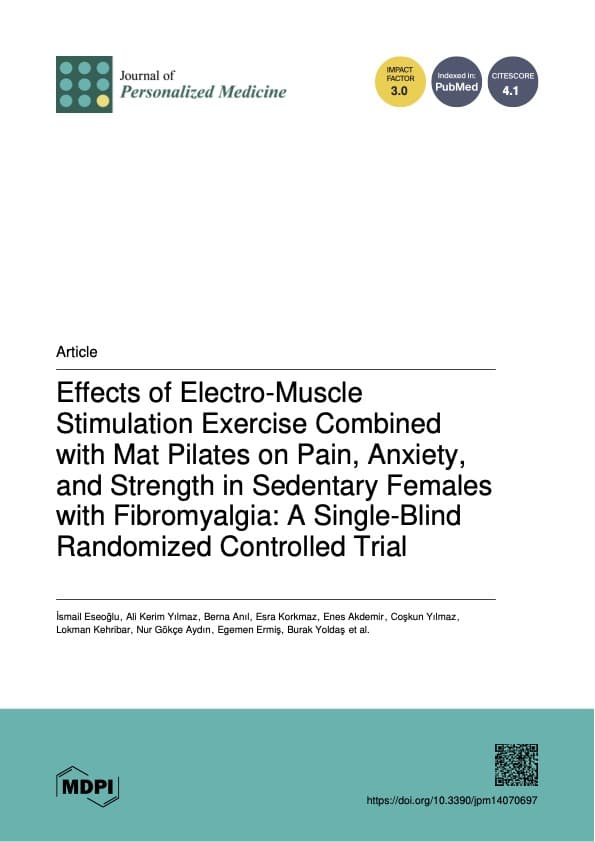
In light of all the above-mentioned information, the results of this study revealed
that mat Pilates exercises combined with EMS provide an effective and reliable method of
improving the pain, anxiety, depression, and strength of female patients diagnosed with
FM.
The Effect of Whole-Body Electromyostimulation Program on Physical Performance and Selected Cardiometabolic Markers in Obese Young Females
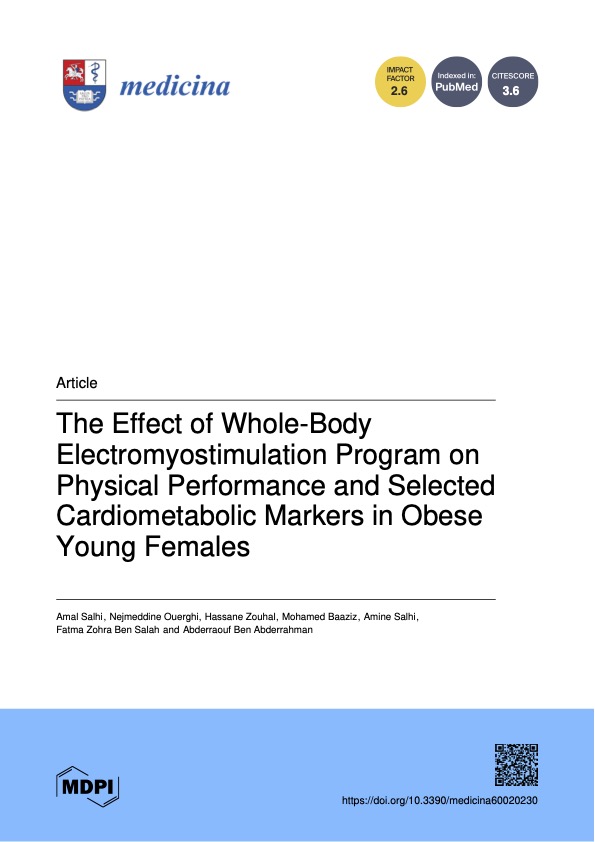
A 12-week whole-body electromyostimulation program significantly improved body composition (skeletal muscle mass, body mass index, body fat, and waist circumference), physical performance (maximal oxygen consumption, jumping and sprint performance), and certain cardiometabolic (plasma level of lipids) and inflammatory markers (C-reactive protein) in obese young women.
Effects of Whole-body Electromyostimulation on knee pain and physical function in adults with symptomatic knee osteoarthritis
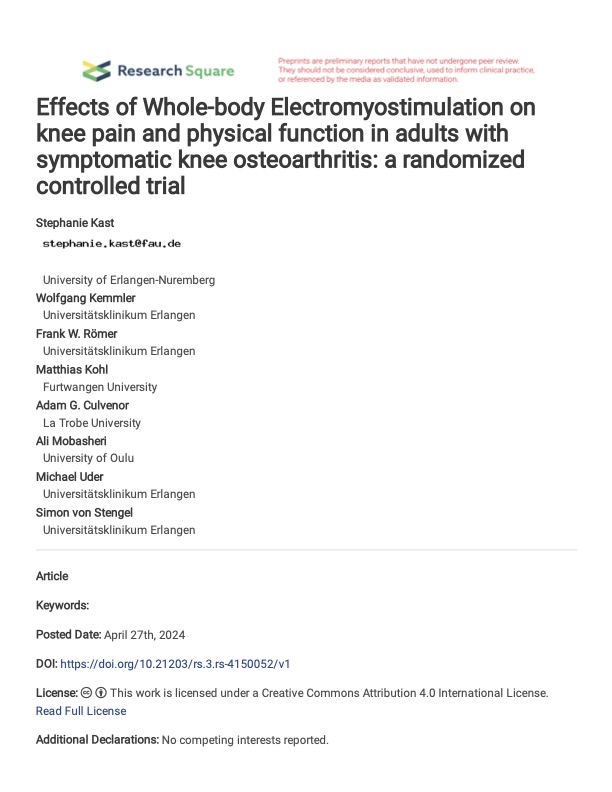
In summary, our findings demonstrated that WB-EMS was highly effective in alleviating pain (KOOS) as primary outcome and improving the other four KOOS scores. Along with the enhancement of the KOOS scores, WB-EMS was more effective in improving pain intensity (NRS), objective lower-limb function (30s sit-to-stand) and maximum strength of hip-/leg extensors compared to a usual care approach.
Acute Effects of Combining Whole-Body Electromyostimulation with Resistance Training in Active Women
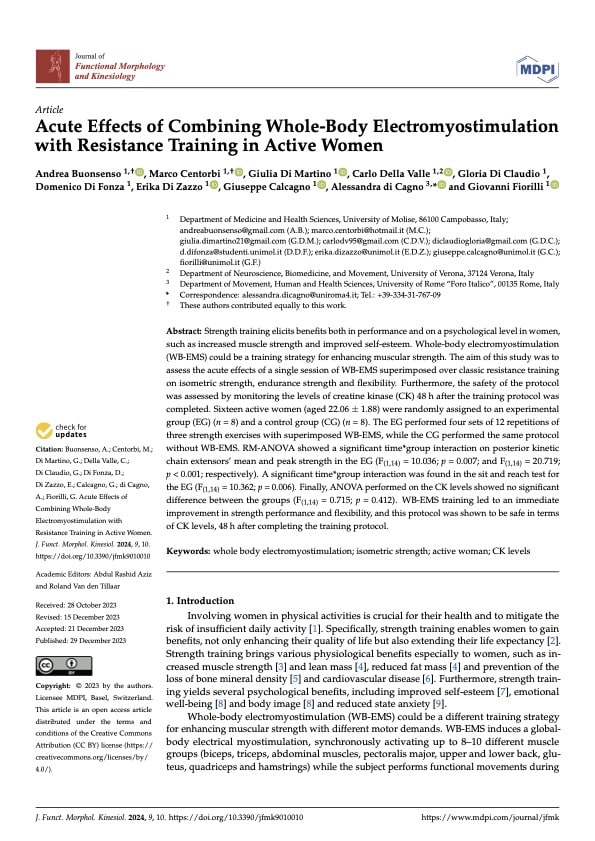
WB-EMS training led to an immediate improvement in strength performance and flexibility, and this protocol was shown to be safe in terms of CK levels, 48 h after completing the training protocol. WB-EMS training represents a strategy for acute strength improvement and flexibility enhancement. These improvements were evident even when employing sub-maximal loads (12RM), highlighting the safety of this resistance training approach. This implies that the protocol may be suitable for female athletes with limited experience or inadequate technique, allowing for strength gains without the need for maximal loads. Furthermore, the application of technology provides a diverse range of training possibilities, ensuring motivation and avoiding dropouts.
Influence of a long-term WB-EMS intervention on parameters of body composition and physical performance among individuals of different age decades between 19 and 81 years
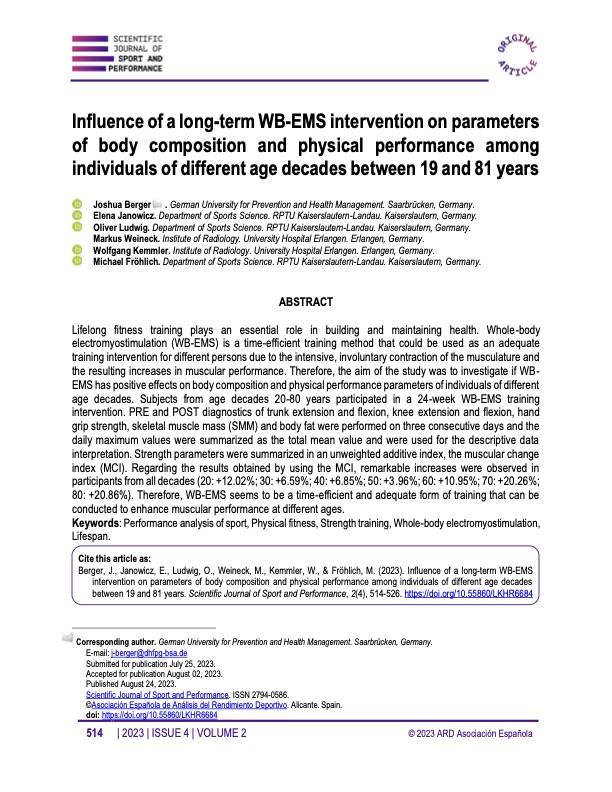
Whole-body electromyostimulation (WB-EMS) is a time-efficient training method that could be used as an adequate training intervention for different persons due to the intensive, involuntary contraction of the musculature and the resulting increases in muscular performance.
Effects of whole-body electromyostimulation training on upper limb muscles strength and body composition in moderately trained males: A randomized controlled study
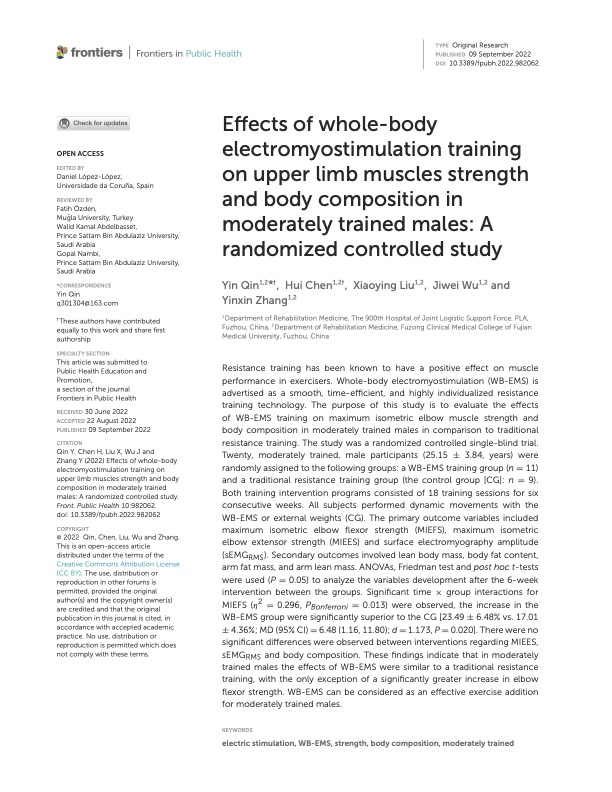
These findings indicate that in moderately trained males the effects of WB-EMS were similar to a traditional resistance training, with the only exception of a significantly greater increase in elbow flexor strength. WB-EMS can be considered as an effective exercise addition for moderately trained males.
A comparison of voluntary and electrically induced contractions by interleaved 1H and 31P-NMRS in humans.
Electrical Stimulation (ES) induced far greater metabolic changes than Voluntary Contraction (VC).
Acute effects of superimposed electromyostimulation during cycling on myokines and markers of muscle damage.
Only Cycling & Electromyostimulation (C+E) caused significant increases in levels of CK and myoglobin.
Can A Superimposed Whole-Body Electromyostimulation Intervention Enhance the Effects of a 10-Week Athletic Strength Training in Youth Elite Soccer Players?
The strength increases identified in the WB-EMS group were all between 8.4% and 33.7% of the initial value.
Comparison between voluntary and stimulated contractions of the quadriceps femoris for growth hormone response and muscle damage.
…showed greater increases in Growth Hormone release, blood lactate concentration, serum CK activity and muscle soreness…
Comparison of the Effects of Electrical Stimulation and Exercise on Abdominal Musculature.
The exercise plus stimulation (ES) group demonstrated the largest significant increases in abdominal strength.
Could Low-Frequency Electromyostimulation Training be an Effective Alternative to Endurance Training?
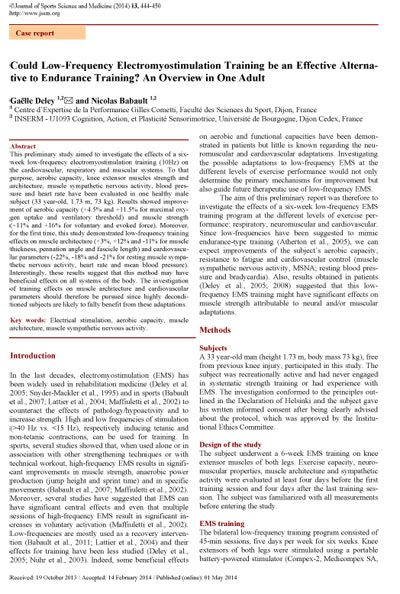
Maximal VO2 increased by 4.5%, maximal power by 16.7% and VO2 at ventilatory threshold by 11.5%.
Effect of combined electrostimulation and plyometric training on vertical jump height.
Increases with respect to baseline ranged between 8.3% for the Counter Movement Jump (CMJA) and 21.4% for the Squat Jump (SJ90°).
Effect of Neuromuscular Electrical Muscle Stimulation on Energy Expenditure in Healthy Adults.
Energy expenditure is still elevated even though NMES intervention is terminated.
Effect of the Combination of Whole-Body Neuromuscular Electrical Stimulation and Voluntary Exercise on Metabolic Responses in Human.
The increase in energy expenditure by the addition of WB-NMES was approximately 23%.
Effect of whole-body electromyostimulation and/or protein supplementation on obesity and cardiometabolic risk in older men with sarcopenic obesity – the randomized controlled FranSO trial.
After 16 weeks, Total Body Fat (TBF) was reduced significantly by 6.7% ± 6.2% in the combined WB-EMS and whey protein supplement group.
Effect of Whole-Body Electromyostimulation on Energy Expenditure During Exercise.
Energy expenditure was 17% higher during the exercise protocol with WB-EMS application.
Effects of a whole-body electrostimulation program on strength, sprinting, jumping, and kicking capacity in elite soccer players.
Increased one-leg maximal strength at the leg press machine (1.99 vs. 1.66 kg/kg), and improved linear sprinting (5m: 1.01 vs. 1.04s), sprinting with direction changes (3.07 vs. 3.25s), and vertical jumping performance (SJ: 38.8 vs. 35.9cm) as well as kicking velocity (1step: 93.8 vs. 83.9 km∙h).
Effects of an electrostimulation training program on strength, jumping, and kicking capacities in soccer players.
Eccentric torque increased at wk-3 (+11.5 +/- 10.4%) and wk-5 (+22.1 +/- 16.4%). A similar increase was obtained in isometric conditions from before to wk-3 and wk-5 (+16.3 +/- 21.3% and +27.1 +/- 22.6% respectively). Ball speed without run-up improved significantly at wk-3 (+6.6 +/- 8.7%) and wk-5 (+9.6 +/- 10.6%). Ball speed with run-up improved significantly at wk-5 (+5.6 +/- 4.0%). For jump performance, we observed a significant increase from wk-3 and wk-5 in CMJ condition for the EMS group (+6.7 +/- 6.3%).
Effects of electrical stimulation on skeletal muscle of old sedentary people.
One major finding is the massive increase of NFATc1-positive nuclei and increase of pCamKII after ES. These cellular responses are clear signs of activation of two pathways involved in muscle adaptation and remodeling. After ES, the number of mixed MHCII/Serca2 fibers tripled.
Effects of electrical stimulation or voluntary contraction for strengthening the quadriceps femoris muscles in an aged male population.
Electrical stimulation produces significant strengthening of aged muscle in the absence of volitional effort.
Effects of electromyostimulation training and volleyball practice on jumping ability.
The mean height and the mean mechanical power maintained during 15-second bouts of consecutive Counter Movement Jumps (CMJs) significantly increased, by 3.8 +/- 4.3% and by 4.3 +/- 4.7% post training, respectively. However, 10 days after the last EMS training session, the maximal height of each jump was significantly higher when compared with baseline. Squat Jump (SJ) height significantly increased, by 6.5 +/- 6.3%, CMJ height by 5.4 +/- 8.1%, and 15-second height by 5.3 +/- 5.5%. Moreover, the mean mechanical power per kilogram of body mass maintained during the consecutive CMJs was significantly higher compared with baseline (15.9 +/- 5.5%).
Effects of electromyostimulation training on muscle strength and power of elite rugby players.
After the 12th week, the -120deg.·s-1 maximal eccentric, 120 and 240deg.·s-1 maximal concentric torque, squat strength (+15.0 +/- 8.0%), squat jump (+10.0 +/- 9.5%), and drop jump from a 40-cm height (+6.6 +/- 6.1%) were significantly improved.
Effects of Neuromuscular Electrical Stimulation Training on Endurance Performance.
High-and low-frequency NMES training can increase functional endurance, with the magnitude of the effects being dependent on the initial condition.
Effects of Whole Body Electrostimulation Associated With Body Weight Training on Functional Capacity and Body Composition in Inactive Older People.
Whole body EMS increased skeletal muscle thickness (MT) in the upper and lower limbs by up to 20%, indicating that the older subjects presented hypertrophy in the limb muscles after this intervention. The group presented increased performance in the 30-s chair stand test, arm curl, 6-min walk test, and handgrip strength test.
Feasibility and Safety of Whole-Body Electromyostimulation in Frail Older People – A Pilot Trial.
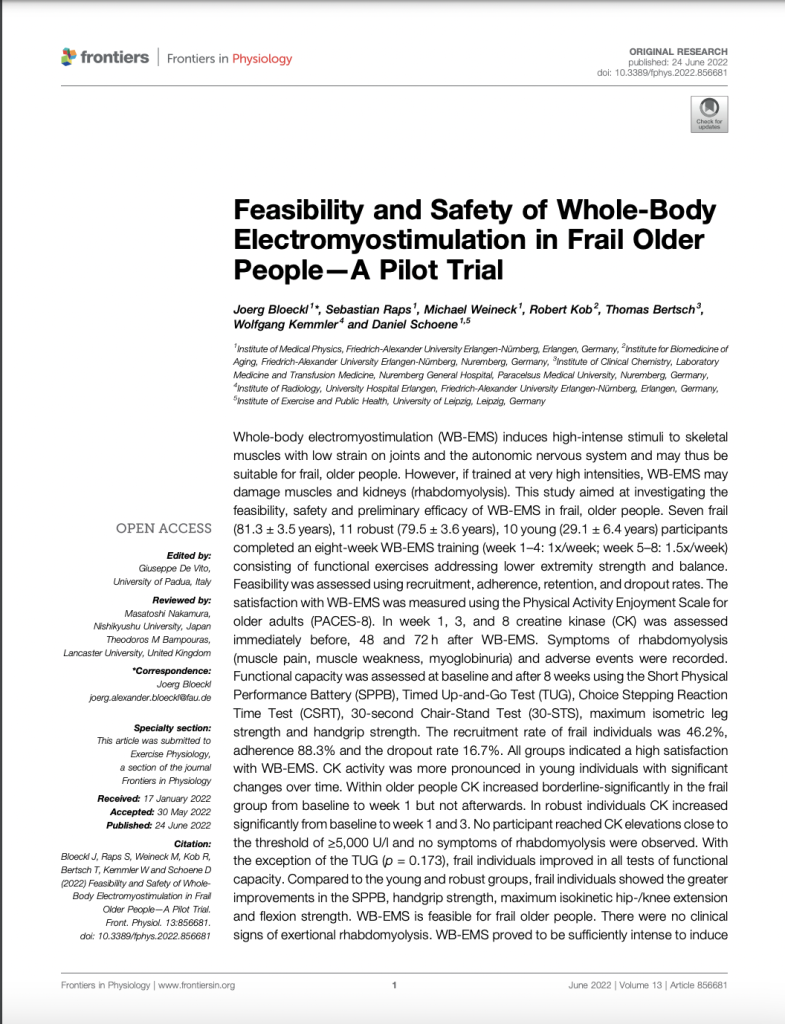
In the frail group (FG) significant improvements were found for maximum isokinetic hip and knee extension and flexion strength, the 30-second chair-stand test and the 5x chair rise test. The frail group improved significantly in the Short Physical Performance Battery, in handgrip strength and the Choice Stepping Reaction Time Test.
Effects of Whole-Body Electromyostimulation on Chronic Nonspecific Low Back Pain in Adults.
Mean intensity of lower back pain (LBP) decreased significantly in the WB-EMS group and remained unchanged in the control group (CG). The maximum isometric trunk extensor strength increased significantly by 14.6% ±18.6% in the WB-EMS group.
Effects of Whole-Body Electromyostimulation on Low Back Pain in People with Chronic Unspecific Dorsal Pain – A Meta-Analysis of Individual Patient Data from Randomized Controlled WB-EMS Trials.
Pain intensity at the lumbar spine (LS) decreased significantly in the WB-EMS group and was unchanged in the control group (CG).
Effects of Whole-Body Electromyostimulation on Physical Fitness in Postmenopausal Women – A Randomized Controlled Trial.
The WB-EMS group scored better agility than the control group at the end of the intervention and was the only group that improved cardiovascular endurance. WB-EMS shows a favorable isolate effect on the development of dynamic leg strength, agility, and cardiovascular endurance.
Effects of Whole-Body Electromyostimulation on Resting Metabolic Rate, Body Composition, and Maximum Strength in Postmenopausal Women – the Training and ElectroStimulation Trial.
WB-EMS has a significantly positive impact on overall and abdominal fat and on strength parameters. Sums of skinfolds were significantly reduced in the WB-EMS by 8.6%. Waist and hip circumferences were also significantly reduced in the WB-EMS, both by ~2.3%. Maximum isometric strength of the trunk and leg extensors of the WB-EMS group significantly improved by 9.9% and 9.6% respectively.
Effects of Whole-Body Electromyostimulation on Strength and Batting Velocity of Female Collegiate Softball Players.
After 8 weeks bench press increased 9.88%, squat increased 9.44%, torso rotational strength increased 20.25%, and batting velocity increased 3.59%.
Effects of whole-body electromyostimulation versus high intensity resistance exercise on body composition and strength. A randomized controlled study.
We observed comparable or at least similar increases of muscle parameters after 16 weeks of WB-EMS compared with the reference method “HIT.” Thus, WB-EMS can be considered as an attractive, time-efficient, and effective option to HIT-resistance exercise for people seeking to improve general strength and body composition.
Effects of whole-body electromyostimulation with and without voluntary muscular contractions on total and regional fat mass of women.
Significant decreases were found in the body weight (-4.56%), body mass index (-5.10%), total fat percentage (-10.11%), total fat mass (-15.12%), and fat percentage/fat mass of all regions of the experimental group (EX).
Efficacy and Safety of Low Frequency Whole-Body Electromyostimulation (WB-EMS) to Improve Health-Related Outcomes in Non-athletic Adults. A Systematic Review.
There is considerable evidence that WB-EMS significantly increases health-related parameters in moderately trained and untrained middle-aged to older non-athletic cohorts. The most prominent effect of WB-EMS is the significant impact on body composition. In this context, sarcopenia and sarcopenic obesity in the elderly might be the most promising targets.
Electrical Stimulation and swimming performance.
Results showed that an electrostimulation program of the latissimus dorsi increased strength and swimming performances of a group of competitive swimmers. A significant increase of the peak torques was measured in isometric, eccentric, and concentric conditions. The swimming times declined significantly for the 25m pull-buoy, and for the 50m freestyle.
Electrical stimulation of human lower extremities enhances energy consumption, carbohydrate oxidation, and whole body glucose uptake.
Electrical stimulation of human lower extremities enhances energy consumption, carbohydrate oxidation, and whole-body glucose uptake. Enhanced carbohydrate oxidation by electrical stimulation may partly influence the post-electrical stimulation effect on enhanced glucose disposal rate.
Electromyostimulation and Plyometric Training Effects on Jumping and Sprint Time.
Significant increases in the Electromyostimulation + Plyometrics Group (EPG) were observed in Squat Jump (7.5%) and Counter-Movement Jump (7.3%) after training. A significant improvement in running time was observed after training (2.4%) in the Electromyostimulation Group (EG).
Electromyostimulation and Whole-Body Vibration Effects in Elder Sarcopenic Patients.
WB-EMS seems a good alternative to resistance-training in old sarcopenic subjects. While the muscle effects were similar to those involving normal weight subjects, the intervention showed also some changes in energetic metabolism affecting fat presence in the body.
Electromyostimulation–a systematic review of the effects of different electromyostimulation methods on selected strength parameters in trained and elite athletes.
Significant gains were shown in maximal strength (isometric Fmax +58.8%; dynamic Fmax +79.5%), speed strength (eccentric isokinetic Mmax +37.1%; concentric isokinetic Mmax + 41.3%; rate of force development + 74%; force impulse + 29%; vmax + 19%), and power (+67%). Developing these parameters increases vertical jump height by up to +25% (squat jump +21.4%, countermovement jump +19.2%, drop jump +12%) and improves sprint times by as much as –4.8% in trained and elite athletes.
Electrostimulation Training Effects on the Physical Performance of Ice Hockey Players.
Isokinetic torque increased significantly for eccentric (37.1 +/- 21.9% at -120°·s-1 and 24.2 +/- 17.9% at -60°·s-1, and concentric conditions (41.3 +/- 37.6% at 60°·s-1 and 49.2 +/- 48.9% at 300°·s-1). The 10m skating time significantly declined (-4.8 +/- 5.8%).
Feasibility and efficacy of progressive electrostimulation strength training for competitive tennis players.
Maximal quadriceps strength significantly increased. Countermovement jump height at week 5 (+5.3%) and week 6 (+6.4%) was significantly higher than at baseline. In addition, 2x10m sprint time at week 6 was significantly shorter (-3.3%)
Functional exercise training and undulating periodization enhances the effect of whole-body electromyostimulation training on running performance.
The periodized and functional whole-body-electromyostimulation training group (PFG) obtained significantly higher improvements in terms of VO2max (2.75 ± 0.89 ml/kg/min), VT2 (2.95 ± 1.45ml/kg/min), VO2max percentage at VT2 (5.13 ± 2.41%), RE at VT1 (−7.70 ± 2.86 ml/kg/km), RE at 90% of VT2 (−15.38 ± 4.73 ml/kg/km), and vertical jump in Abalakov modality (2.95 ± 0.94 cm).
High Voltage Electrical Stimulation in the Augmentation of Muscle Strength – Effects of Pulse Frequency.
We obtained significant increase in muscle strength following 6 weeks of NMES; the strength gained was still retained 3 weeks following cessation of training.
Impact of Active Recovery and Whole-Body Electromyostimulation on Blood-Flow and Blood Lactate Removal in Healthy People.
The analyses showed a substantially greater Peak Blood Velocity (PBV) (-0.27 [-0.68; 0.14], 3/36/61%) in WB-EMS compared to CON. After 60 min of the recovery process, Resistive Index (RI) decreased substantially more in WB-EMS than in CON likely due to the intervention. Further, the pain/discomfort levels at this point were also lower in WB-EMS compared with CON (0.66 [-0.12; 1.45], 84/12/4%).
Impact of whole body electromyostimulation on cardiometabolic risk factors in older women with sarcopenic obesity: the randomized controlled FORMOsA-sarcopenic obesity study.
The study clearly confirms the favorable effect of WB-EMS application on the Metabolic Syndrome (MetS) in community-dwelling women aged ≥ 70 years with Sarcopenic Obesity (SO). In summary, we considered this novel technology an effective and safe method to prevent cardiometabolic risk factors and diseases in older women unable or unwilling to exercise conventionally.
Influence of Whole-Body Electrostimulation on Human Red Blood Cell Deformability in Athletes (Soccer Players).
WB-EMS significantly enhances RBC deformability and thus may improve blood circulation and oxygen transport to the muscles and organs of elite soccer players. The maximal strength (1RM) of professional soccer players significantly increased up to +33% after 7 weeks (14 sessions) and up to +43% after 14 weeks (28 sessions) of dynamic WB-EMS.
Metabolic and cardiovascular responses during voluntary pedaling exercise with electrical muscle stimulation.
A significantly higher oxygen uptake (VO2), heart rate, and respiratory gas exchange ratio were observed during the exercise periods with EMS despite the constant workload. These changes were accompanied by an elevated blood lactate concentration, suggesting the existence of additional fast-twitch motor unit (MU) recruitment during the exercise with EMS.
Normal Trunk Muscle Strength and Endurance in Women and the Effect of Exercises and Electrical Stimulation.
Low-frequency electrical stimulation and exercises significantly increased isokinetic back-muscle strength and endurance.
Once-Weekly Whole-Body Electromyostimulation Increases Strength, Stability and Body Composition in Amateur Golfers.
WB-EMS application is effective to enhance stability, maximum strength, body composition and, to a lower extent, low back pain in amateur golfers.
Percutaneous Electrical Stimulation in Strength Training
Significant increases in muscle and fiber cross-sectional area, isokinetic peak torque, maximal isometric and dynamic strength, and motor performance skills have been found after percutaneous electrical stimulation training.
Physiological responses and perceived exertion during cycling with superimposed electromyostimulation.
The main findings of this study are greater metabolic changes (lactate, respiratory exchange ratio, BE, HCO-3, Pco2) during cycling with EMS compared with normal cycling.
Regular Muscle Electrical Stimulation Could Act Favorably On Bone Mineral Density in Healthy Aged Subjects.
NMES contributes to increasing local blood flow and augmenting circulation of the components necessary for bone formation. When the NMES was superimposed onto voluntary muscular contractions the bone mineral density enhanced more on the trochanters and the whole legs than NMES or voluntary muscular contractions carried out alone.
Superimposed whole-body electrostimulation augments strength adaptations and type II myofiber growth in soccer players during a competitive season.
Observed significant increases in myofiber size of 8.9 +/- 8.5% in type II fibers. Increase in type I muscle fiber size of 4.1 +/- 5.5%. Also observed significant increases in relative maximal strength at leg press (15.1 +/- 13.3%) and at leg curl machine (8.5 +/- 9.3%).
Supplemental EMS and Dynamic Weight Training – Effects on Knee Extensor Strength and Vertical Jump of Female College Track & Field Athletes.
Supplementing dynamic contractions with EMS appears more effective than EMS-only, or weight training only, for increasing knee extensor strength and vertical jump in female track & field athletes.
The Effects of Combined Electromyostimulation and Dynamic Muscular Contractions on the Strength of College Basketball Players.
EMS combined with dynamic contractions, in which the muscle is stimulated during both concentric and eccentric phases of contraction, produced greater strength gains than either method alone.
The effects of electromyostimulation training and basketball practice on muscle strength and jumping ability.
Isokinetic strength significantly increased under eccentric conditions (+ 29% at –120 × s–1, + 37% at – 60deg × s–1) and under concentric conditions at high velocities (+ 43% at 360deg × s–1, + 36%, + 30%, and + 32% at 300, 240, and 180deg × s–1, respectively). Squat jump performance increased significantly by 14%.
The effects of neuromuscular electrical stimulation training on abdominal strength, endurance, and selected anthropometric measures.
The stimulation group had a 58% increase in abdominal strength and a 100% increase in abdominal endurance. Waist circumference decreased by 3.5 cm in the stimulation group. All subjects in the stimulation group felt that their midsections were more “toned” and “firmed” and 54% felt that their posture had improved
The effects of whole-body electromyostimulation (WB-EMS) in comparison to a multimodal treatment concept in patients with non-specific chronic back pain – A prospective clinical intervention study.
The Numeric Rating Scale (1–10) improved statistically and clinically significantly by 2 points. The Oswestry Disability Index was reduced by 19.7 points. The North American Spine Society Instrument and most of the Short Form 36 items improved significantly. WB-EMS is at least as effective as a multimodal treatment, which is often referred to as being the golden standard.
The Efficacy and Safety of Whole-Body Electromyostimulation in Applying to Human Body: Based from Graded Exercise Test.
There was a significant decrease in systolic blood pressure (SBP) and an increase of oxygen uptake from stages 3 to 5 of the graded exercise test (GXT). The psychophysiological factors, which consisted of soreness, anxiety, fatigability, and sleeplessness were significantly decreased after the experiment.
The Impact of Whole-Body Electromyostimulation on Body Posture and Trunk Muscle Strength in Untrained Persons.
We were able to prove a significant improvement of the isometric strength and torque of trunk extension and flexion. The strength increases identified were on average between 15.0 and 21.4% (force) and between 15.9 and 26.6% (torque).
The Influence of WB-EMS-Training on the Performance of Ice Hockey Players of Different Competitive Status.
Jumping power increased by 5.15%, 10m skating time decreased by 5%, and maximum isokinetic force at 300deg/s increased by 7%. Isokinetic torque at 60deg/s and vertical jump height were collected as secondary variables and showed increases of 5.45 and 15.15%, respectively.
Whole-body electromyostimulation as a means to impact muscle mass and abdominal body fat in lean, sedentary, older female adults – subanalysis of the TEST-III trial.
Abdominal fat mass decreased by 1.2% ± 5.7%. Appendicular muscle mass increased 0.5% ± 2.0%. Waist circumference was reduced by 1.1 ± 2.1 cm. Lean body mass of the upper legs increased by 0.5% ± 2.5%. Fat content of the upper leg decreased by 0.8% ± 3.5%. Maximum isometric strength of the leg extensors increased by 9.1% ± 11.2%.
Whole-Body Electromyostimulation Improves Performance-Related Parameters in Runners.
Participants in the WB-EMS group improved VO2max by 5.2%, aerobic and gas exchange threshold values, running economy, and vertical jump compared to the control group.
A Single Session of Whole-Body Electromyostimulation Increases Muscle Strength, Endurance and proNGF in Early Parkinson Patients
The positive impact of the WB-EMS protocol on physical functioning, and eye–hand coordination, makes this intervention a promising strategy to improve motor and non-motor symptoms in PD patients.











































